Many people who lived in southeast Fort Worth during the second half of the twentieth century remember it. Most of them remember it vaguely. A few of them remember it vividly. But whether vaguely or vividly, they remember the looming stone house on Foard Street more with questions than answers.
But a few questions can be answered. Those answers tell a story of oil barons, the Ku Klux Klan, a prominent philanthropist, Miss Fort Worth, a country music performer, and horses and cows and Cats.
Let the questions begin.
What was that stone house on Foard Street called? The property had a name: “Rockwood Farm.” The house had a name: “Rockwood Manor.”
Where was it? 4430 Foard Street south of Wilbarger Street.
When did it exist? Rockwood Manor stood from 1925 to 1981.
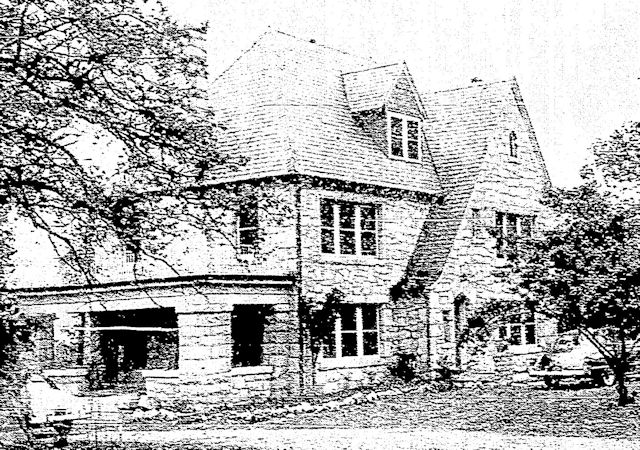

What are some details of the property? Rockwood Farm was four acres of land stretching from Foard Street west to Wichita Boulevard. The property was big enough to support horses and cows—and it did. The land originally included an oval track for horses, an orchard, dozens of big oaks, and a terrazzoed walkway and fish pond. There were also a guest cottage, a stable, and a garage—all of stone.
What are some details of the house? Rockwood Manor had 4,900 square feet of floor space spread over three stories and a basement. The roof was slate. There were thirteen rooms and four fireplaces. The interior walls were of oak. The exterior walls were of Georgian stone and brick—eighteen inches thick.
Under the first floor the joists were 2x12s. The front door weighed three hundred pounds and featured hardware of hammered nickel. The house had a seventy-five-pound bronze chandelier imported from England.
On the aerial photo above I have labeled some elements based on old aerial photos.
Who built the house? Ah, glad you asked. In 1952 the Star-Telegram wrote of the house: “The house was built by Brown Harwood, veteran Fort Worth realtor.”
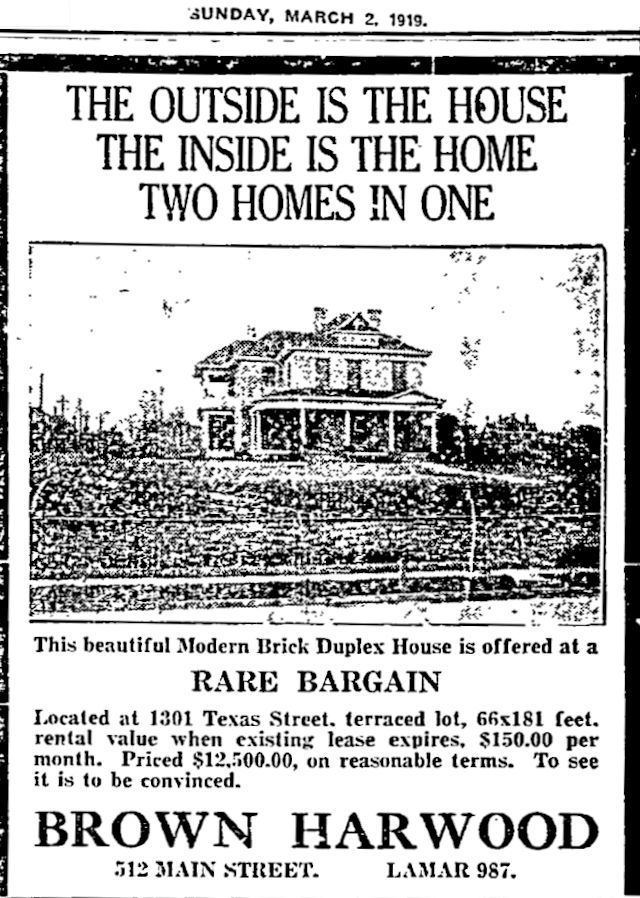 Brown Harwood, born in 1872, began buying and selling and developing real estate (there is a Brown Harwood addition in Meadowbrook) in Fort Worth in 1902.
Brown Harwood, born in 1872, began buying and selling and developing real estate (there is a Brown Harwood addition in Meadowbrook) in Fort Worth in 1902.
But in 1981 the Star-Telegram wrote of Eloise Gunstanson, then the current owner of Rockwood Farm: “Mrs. Gunstanson said that as far as she knows, the stone house was built in 1925, probably by the Ku Klux Klan. ‘I’ve got . . . rather I had a letter in there from the grand dragon of the Ku Klux Klan dated September 1925 and sent to the First National Bank and it says something about the cornerstone of the house.’”
So, you ask, who built Rockwood Manor: Brown Harwood or the Ku Klux Klan?
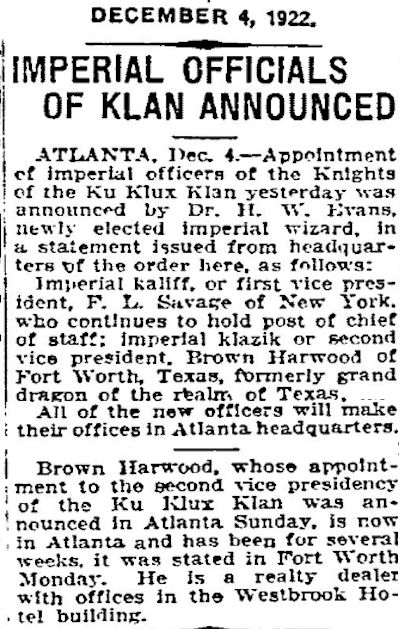
Did I mention that in addition to wearing the hat of a “veteran Fort Worth realtor,” the other hat (or hood) that Brown Harwood wore was that of imperial klazik (vice president), the no. 2 man in the Ku Klux Klan national leadership? Upon his election as imperial klazik in 1922 Harwood moved from Fort Worth to Atlanta, national headquarters of the Klan.
 Elected imperial wizard (leader) of the national Klan in 1922 was Dr. Hiram Wesley Evans, a Dallas dentist. Thus, two Metroplex men—Evans and Harwood—led the Klan during its most successful period: Membership increased from one million in 1922 to two million or perhaps even five million (and the tacit approval of millions more) in 1925. (Photos from Wikipedia.)
Elected imperial wizard (leader) of the national Klan in 1922 was Dr. Hiram Wesley Evans, a Dallas dentist. Thus, two Metroplex men—Evans and Harwood—led the Klan during its most successful period: Membership increased from one million in 1922 to two million or perhaps even five million (and the tacit approval of millions more) in 1925. (Photos from Wikipedia.)
Harwood had been a charter member of the Fort Worth Klan in 1921, had been klaliff (vice president) of the Fort Worth Klan and had been great titan (head of a Klan province) and grand dragon (head) of the Texas Klan before being elected imperial klazik of the national Klan. (Remember that Mrs. Gunstanson in 1981 said she had a letter “from the grand dragon of the Ku Klux Klan.”)
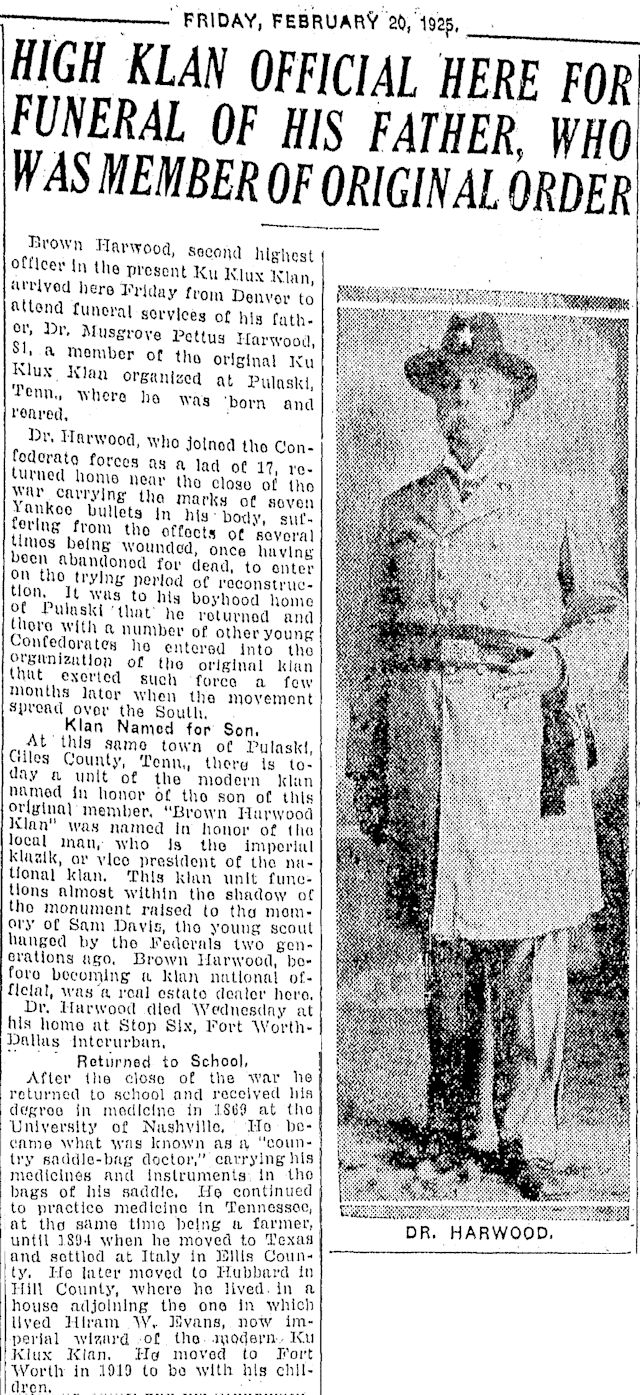 In fact, Brown Harwood was a second-generation Klan member. Harwood’s father, a resident of Fort Worth from 1919 until his death in 1925, had been a member of the original Ku Klux Klan that organized in Pulaski, Tennessee, in 1866. The Star-Telegram said the modern Klan in Pulaski had named a “unit” after son Brown Harwood upon his election as imperial klazik in 1922.
In fact, Brown Harwood was a second-generation Klan member. Harwood’s father, a resident of Fort Worth from 1919 until his death in 1925, had been a member of the original Ku Klux Klan that organized in Pulaski, Tennessee, in 1866. The Star-Telegram said the modern Klan in Pulaski had named a “unit” after son Brown Harwood upon his election as imperial klazik in 1922.
 But Brown Harwood served only three years in that august office. His resignation on April 14, 1925 was front page news. Harwood said that he was yielding his office to “someone who might be able to lift the torch higher and bear it forward better and farther than I can ever hope to do.”
But Brown Harwood served only three years in that august office. His resignation on April 14, 1925 was front page news. Harwood said that he was yielding his office to “someone who might be able to lift the torch higher and bear it forward better and farther than I can ever hope to do.”
Although Harwood did not mention it, his resignation came on the day that Madge Oberholtzer died and eleven days after former Indiana Klan Grand Dragon David C. Stephenson was indicted for abducting and raping her. With Oberholtzer’s death, the crime charge was escalated to murder. By 1925 the Klan already faced increasing social opposition, and the Stephenson scandal (he was convicted that November) tarnished the Klan’s reputation and increased social opposition. By 1930 Klan membership was greatly diminished.
The Star-Telegram in announcing Brown’s resignation pointed out that imperial klazik was “the second highest office in the klan in the United States.”
By September 1925—the date of the letter belonging to Mrs. Gunstanson—Harwood had resigned from his national Klan office. Did Harwood build Rockwood Manor and dedicate it to the Klan on the cornerstone? Or did the Klan finance the construction of Rockwood Manor as a token of appreciation for Harwood’s three years of service during the Klan’s heyday? Did First National Bank hold the mortgage on the property?
Regardless, there is no record of Harwood having lived in the house on Foard Street, although, as we will see, he did live nearby.
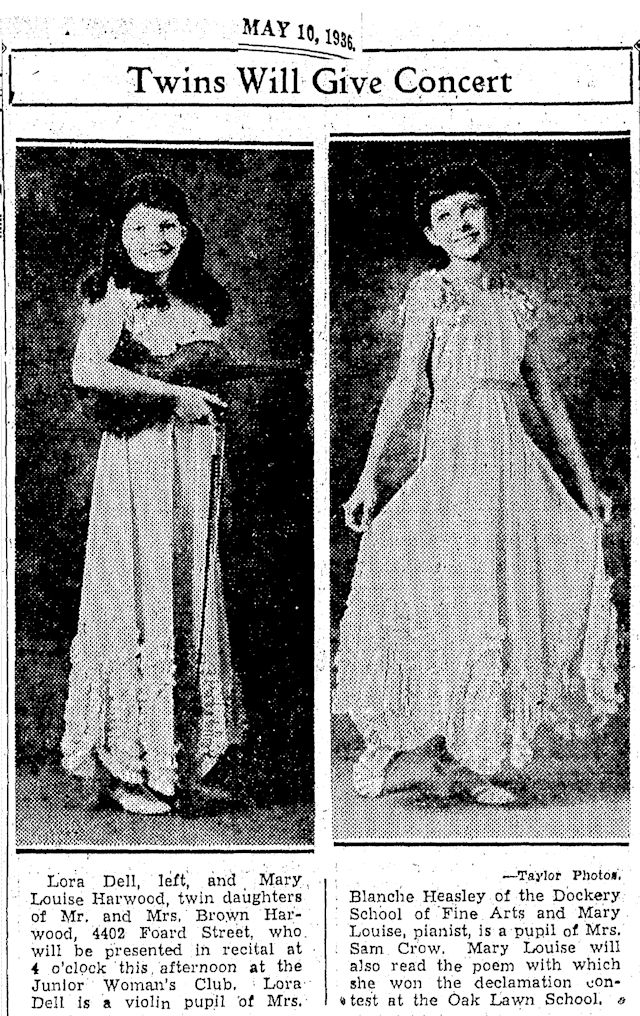 Brown Harwood, upon his resignation from KKK national office, returned to Fort Worth and resumed his real estate career. Harwood and family were active in their neighborhood of Glen Garden/Oaklawn. Brown also raised champion show dogs. His twin daughters attended Oaklawn School, which had opened in 1922 when the Oaklawn area had its own school district. Fort Worth annexed the school district in 1925. The current Oaklawn Elementary School opened in 1936.
Brown Harwood, upon his resignation from KKK national office, returned to Fort Worth and resumed his real estate career. Harwood and family were active in their neighborhood of Glen Garden/Oaklawn. Brown also raised champion show dogs. His twin daughters attended Oaklawn School, which had opened in 1922 when the Oaklawn area had its own school district. Fort Worth annexed the school district in 1925. The current Oaklawn Elementary School opened in 1936.
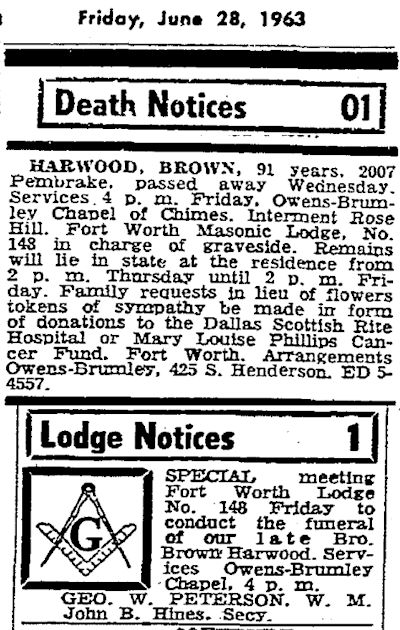 Brown Harwood died in 1963 and was given a Masonic funeral.
Brown Harwood died in 1963 and was given a Masonic funeral.
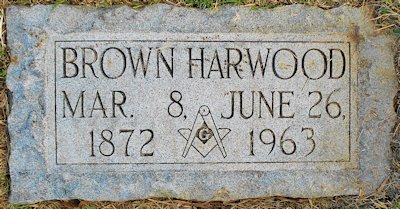 The former imperial klazik is buried in Rose Hill Cemetery.
The former imperial klazik is buried in Rose Hill Cemetery.
So. If Brown Harwood never lived in the house that he (or the Ku Klux Klan) built, who did live in it?
How much time have you got?
The first occupant of Rockwood Manor was oilman Marion Linn Long (1892-1987).
 In 1910 Marion Long was seventeen, living on Henderson Street in Quality Hill in a household that included his father (a cattleman), his sister Alice (who was married to jeweler John H. Greer), a chauffeur, a cook, and a yardman.
In 1910 Marion Long was seventeen, living on Henderson Street in Quality Hill in a household that included his father (a cattleman), his sister Alice (who was married to jeweler John H. Greer), a chauffeur, a cook, and a yardman.
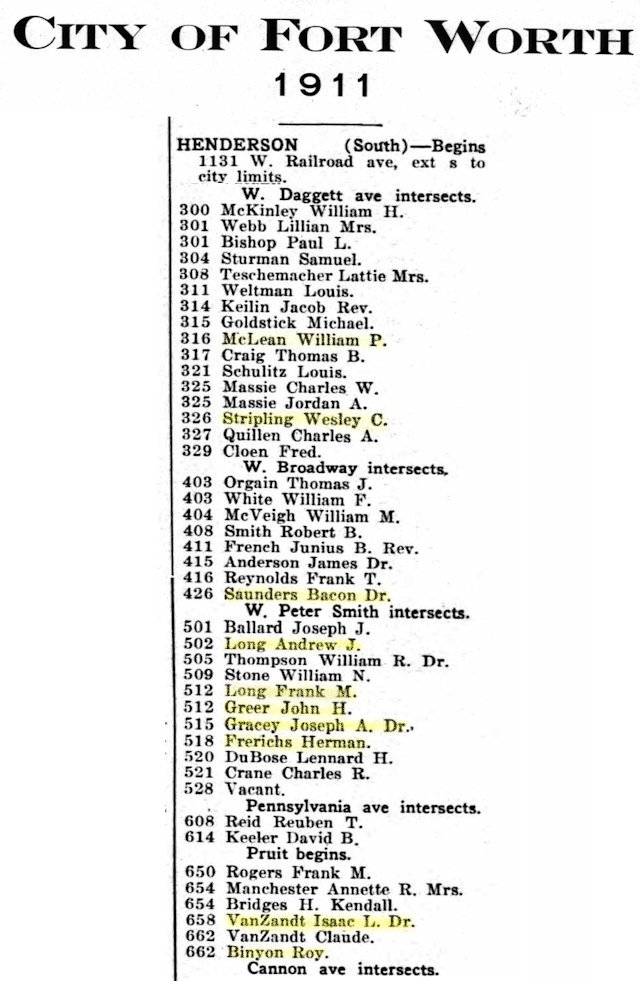 The 1911 city directory shows that living near the Long family on Henderson Street were William Pinckney McLean, who was an attorney, judge, U.S. representative, father of Jeff McLean, and namesake of McLean Middle School; Wesley Capers Stripling; Dr. Bacon Saunders; Andrew Jackson Long, a cattleman and banker whose 1916 house on Elizabeth Boulevard still stands; Dr. Joseph A. Gracey, president of the Tarrant County Medical Society; cotton broker Herman Frerichs; Dr. Isaac Lycurgus Van Zandt, brother of Major Khleber Miller Van Zandt; and Roy Binyon of Binyon-O’Keefe Transfer and Storage Company.
The 1911 city directory shows that living near the Long family on Henderson Street were William Pinckney McLean, who was an attorney, judge, U.S. representative, father of Jeff McLean, and namesake of McLean Middle School; Wesley Capers Stripling; Dr. Bacon Saunders; Andrew Jackson Long, a cattleman and banker whose 1916 house on Elizabeth Boulevard still stands; Dr. Joseph A. Gracey, president of the Tarrant County Medical Society; cotton broker Herman Frerichs; Dr. Isaac Lycurgus Van Zandt, brother of Major Khleber Miller Van Zandt; and Roy Binyon of Binyon-O’Keefe Transfer and Storage Company.
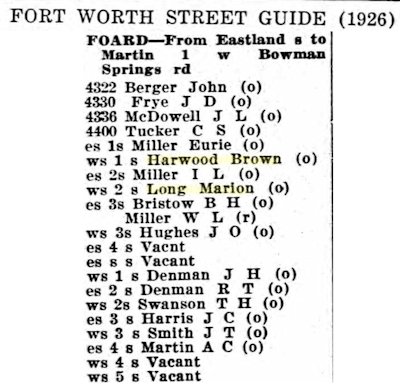 By 1926 Marion Long was living in the house on Foard Street. Fort Worth had annexed the Oaklawn area, although the houses on Foard Street did not yet have street numbers. Notice that Brown Harwood lived near Long’s Rockwood Farm.
By 1926 Marion Long was living in the house on Foard Street. Fort Worth had annexed the Oaklawn area, although the houses on Foard Street did not yet have street numbers. Notice that Brown Harwood lived near Long’s Rockwood Farm.
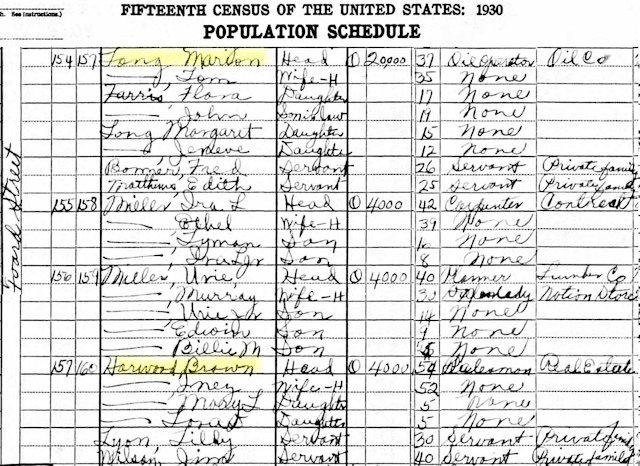 Long and Harwood were still near neighbors on Foard Street in 1930, each household with two servants. Long put the value of his property at $20,000 ($293,000 today).
Long and Harwood were still near neighbors on Foard Street in 1930, each household with two servants. Long put the value of his property at $20,000 ($293,000 today).
In 1936 oilman Marion Linn Long sold Rockwood Farm to another oilman: Adlai McMillan Pate Sr.:
That Old House on Foard Street (Part 2): “Built for 1,000 Years”






Mike I loved this article since I lived on Foard St a while across from Belinda Whitlock Laurence. Never knew about the Klan connection either. My dad grew up here & you’d think he’d have known it too. Love all the history Mike.
Thanks, Kathy. I had no idea where this story was going to take me when a reader asked me what I knew about an old house on Foard Street. I thought she was talking about a big wooden house just off Wilbarger. I was not even aware of the Foard house (and I dated a girl who lived on Foard!).
Is Harwood buried at Rose Hill Cemetery in Tyler?
Rose Hill in Fort Worth.
From the early forties until the mid fifties the home was owned and occupied by Grace Humphries Hood MD, and her son Jackson Alfred Turner. We were classmates at Oaklawn and Poly and I visited there a number of times. Dr. Hood was purported to House unwed mothers in an apartment. There was a hidden tunnel supposedly between that house and the Goolsby home next door north purportedly having something to do with prohibition. I never saw a tunnel but did see apivoting mirror on the top of the third floor staircase and also saw a door disguised as a dresser which gave access to the attic. The house was sold to the Mussato family whose oldest daughter Irene married a famous major league ballplayer.
Thanks for those details. The later history of the house, with Dr. Hood and the Mussatos, is in Part 2.
Actually, Irene was my mother, it was her older sister Norma that married the baseball player..Dick Williams.
I lived near 4430 Foard St from 1954 to 1972 and I remember that Rockwood Manor had a major fire some time in the 1960’s, I’m guessing the date.
My sister and I with 2 other friends actually entered the property to investigate the rumored “ghosts”. This was around the year 1963 and it was vacant because it had been in a massive fire. We only walked around on the first floor because when we tried to go upstairs, my sister’s leg fell through the severely burnt stairs. I didn’t see any mention of this fire. It’s late so maybe I missed it. Would love to hear what you know of this other fire. We really LOVED the article. We are going to my 50th Poly Reunion Saturday night Aug 5th and I’m sure we will talk about this great article. Thank you for writing it.
Thanks, Jana. The 1981 fire is the only one I could document. The earlier fire may not have been reported in the newspaper. See you at the reunion.
Marion Linn Long built a substantial home in 1914 in Borden County where he purchased land to raise cattle. This was the house where I was raised and it is still standing.
Very nice. I worked for some of the Pates I think. At Texas Refinery. A.M. Pate (JR or Senior) I don’t remember.
Thanks, Norland. Sr. died in 1947, so it musta been Aggie. I had no idea the Pates had East Side ties.
Hi Mike. Great article. I will read Part 2 next. A lot of movers and shakers, something I was never exposed to. Well, when it comes to the Klan, that is a good thing. First time I have heard Glen Garden/Oaklawn mentioned together. As you know, I walked passed the Oakland elementary school for years (I was already in middle school),on my way to Glen Garden country club. Not to play golf, but to caddie, lol.
Thanks, Ramiro. I was very surprised by the varied history of that property.